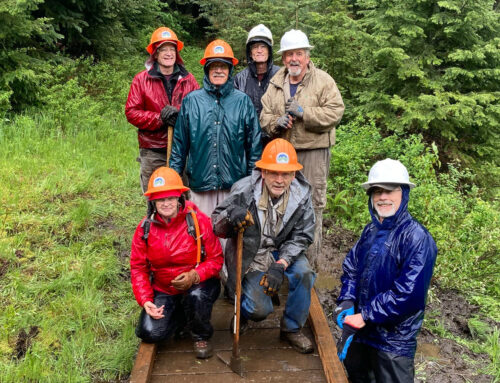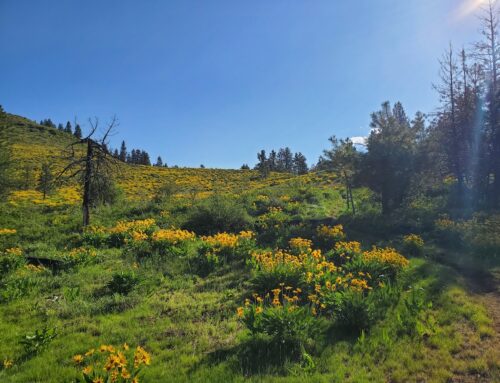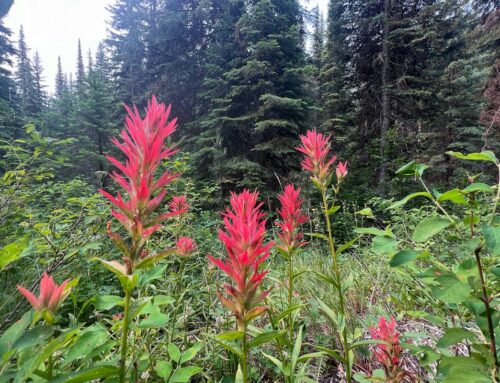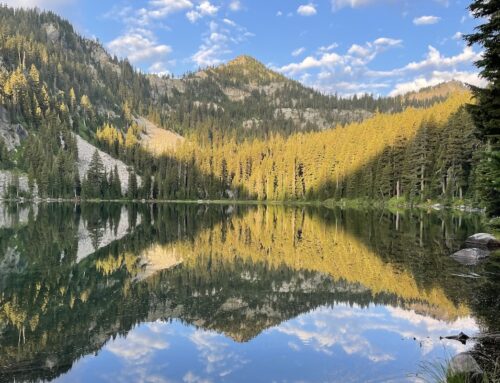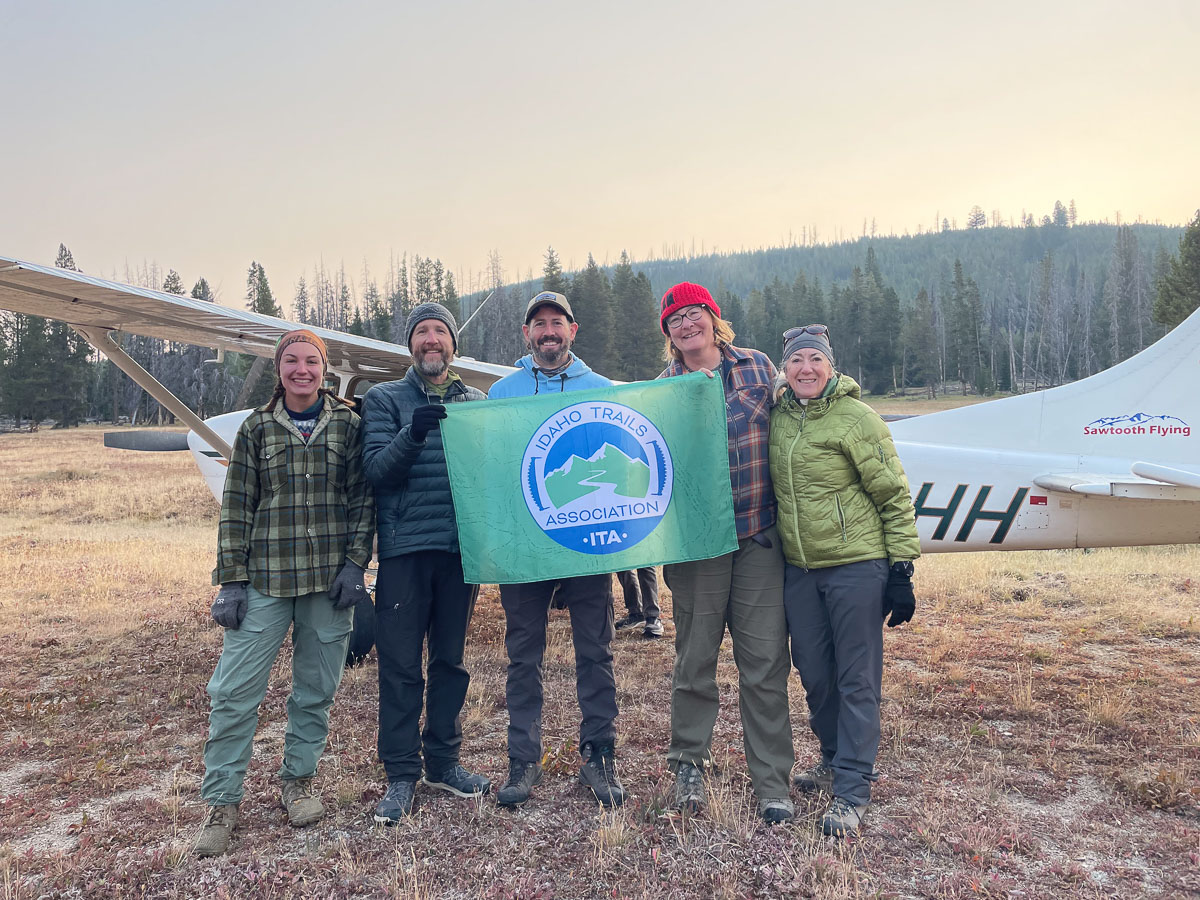
Jess (red hat) on the 2024 Cold Meadows Project
Jess brings a wealth of experience to ITA—from working as a wilderness ranger to decades in nonprofit and public service—but what stands out most is her passion for building community and connecting people with the outdoors. Since jumping into leadership with ITA in 2021, Jessica has led trail crews with a mix of grit, grace, and humor, reminding us all that stewardship is more than just swinging a tool—it’s about shared purpose and place. We’re so grateful to have Jess as part of our ITA family and for the way she continues to give back to Idaho’s trails!
What is your background in? What are some of the things you enjoy doing for fun?
I went to College of Idaho and studied psychology and creative writing, although I originally wanted to study art and be a wolf biologist. I’d always loved the outdoors and spent a lot of time camping and fishing with my dad growing up, but didn’t end up studying natural resources as an undergrad and kind of lost touch with that side for a while. When my eventual husband and I moved to Bozeman in 1999 I found my way back to the outdoors with two years at the Montana Conservation Corps as a crewleader and Americorps volunteer. That experience led to 25 years of nonprofit work and federal service including several stints as a Forest Service wilderness ranger, taking a couple of years off to get a master’s degree in Mass Communications, spending several years working for grassroots stewardship organizations in Colorado, running a community radio station in Boise, and most recently working for the Idaho Humanities Council. I’ve been building up my art practice for several years now and started doing that full-time at the end of December out of my studio in Garden City. The main thing holding all of that jumble of experiences together is advocating for the importance of community when it comes to taking care of our mutual resources, something that I continue to explore with my art.
For fun in addition to those types of fun, I enjoy music, a good beer with friends in Garden City or wherever, skateboarding with friends (a pretty new thing), making art, snowboarding, trivia, reading a good book, hiking, and most definitely backpacking and my times with ITA.
How and why did you first get involved with ITA? What are the different ways you’ve volunteered for ITA over the years?
I’d gotten to know Jeff Halligan and Jenni Blake in 2002 and 2003 through Northwest Youth Corps (our crew helped build the Crestline Trail outside of McCall) and my season as the wilderness ranger at Cabin Creek in the Frank Church, and when my family moved back to Boise in 2015 I had been keeping my eye on this newer group called ITA forming back home. I did one trail project with ITA that year but with a younger kiddo and a pretty all-consuming job I didn’t really start getting involved until 2021 when Jeff reminded me they were always looking for crew leaders and my plate was a little less full. I was a little rusty when it came to my trail skills but rediscovered my zeal for swinging a tool with good people, and since then I have led 1-4 ITA projects a year. I also help out as I can volunteering for outreach opportunities and fundraising.
What do you like about volunteering with ITA?
When I started my career, I spent A LOT of time outside over multiple seasons and was humbled, again and again, by living and working in places like the Frank Church and the Beartooths. I feel extremely lucky to have spent that much time out there because it really drove home for me how insignificant we are in the big picture of these landscapes but how what we can do in our daily lives actually has a huge impact wherever we are. I made a lot of mistakes that some in handy when working with volunteers since I like others to benefit from my own missteps. While I can’t spend as much time in the backcountry now I love volunteering for ITA because of the community it’s built around stewardship of our incredible public lands. There’s this great mix of volunteers who’ve been doing this for decades working alongside people who are signing up for a new challenge, and that mix is really important to cultivate as part of the experience. At this point in my life, being able to get way back into places like the Frank Church, use our phones strictly for capturing memories, and reconnect with people over the work in front of us is the ultimate reset. I come back from these trips with a reminder of what it means to be human, and the physical challenge is really vital as part of that. ITA’s commitment to safety, fun, and learning while getting good work done is fundamentally baked into everything the organization does from top to bottom. Stewardship is much, much more than just swinging a tool or getting a log cut out. So basically, I love volunteering for personal reasons but overall I value that my contributions are just one small piece of a greater effort. Each project also gets me closer to my goal that I set for myself in 2021, which is to spend at least 30 days in the backcountry each year.
Most memorable backcountry or ITA experience?
I struggled picking just one experience since every ITA trip I’ve been on has been memorable in the right ways, and I’ve had lots of memories over the years that fall into the Type 3 fun category. I’m going to go with a random wilderness ranger story involving a dog. Dogs share many things with humans including their ability to get themselves into sticky situations hours away from help, and when I worked as a ranger I saw everything from a dog getting ejected out of a waterfall and surviving (and like most labs would, probably enjoying the experience) to getting to find out that bulldogs really don’t breathe very well at 9,000 feet and have to hike very, very slowly and slobber all over the trail.
The dog story I’m going to tell was the time that I was camped out at Rainbow Lake in the Beartooths and a man came up to me asking if I’d seen their dog. The dog was getting up there in age, maybe 12 or so, and was deaf. Something had spooked her when they were pulling up camp and after several hours of searching they just couldn’t find her. This was 8 miles back from the trailhead in country that would be rough for any animal that couldn’t hear; we were in the middle of a hanging glacial valley with rushing creeks and a trail that had taken 40 years to construct due to the steep and rocky terrain in the East Rosebud drainage. The owner had to make the difficult choice of deciding when to head back down the trail, and when I said I would keep an eye out for her he began sobbing and then trying to compose himself. I recall now that they lived in Idaho, maybe around Twin Falls, so this was not an easy decision for him to set off with the knowledge that they would be driving away from their beloved pet and her unknown fate. You could see that look of remorse or second-guessing that anyone who really loves their pet would feel in that moment knowing their animal was lost and unable to find their way home. I took his number and contact info. I felt terrible for him and his family and spent the next couple of days cleaning up trash and fire rings around the lake feeling sad that the dog would likely not turn up. I did not find any sign of her.
A couple of days later, I was scheduled to head another eight miles up the trail and was packing up camp when Sheena the dog (white and orange, maybe some kind of setter) turned up next to my tent. She was skinny and freaked out but pretty relieved to see me. I called into the office on the satellite phone and said I had a dog I needed to walk out and made new plans with the front office to have someone meet me to get Sheena to Red Lodge and get in touch with her family. I made a leash out of p-cord and hiked down to the East Rosebud trailhead where I met a coworker with a truck. He told me the family had all started crying with joy and relief on the phone when they heard the dog was alive, and he took Sheena back to Red Lodge where she would get picked up the next day by the owner who was on his way back there from Idaho. The next day I headed back up the trail and hiked 16 miles into where I had meant to go the day before. When I came out from that hitch I found that the family had left me a very nice note and a small token of appreciation. In the middle of a season where I’d started getting burnt out and frustrated trying to prevent resource damage in a drainage that was being loved to death, it felt good to get a win. I like to think that Sheena was spoiled rotten for the rest of her days.
Life may conspire to try and make idealists cynical in the face of small and big losses and challenges, but I guess this story captures what I mean by how significant small things can be in the bigger picture. Putting ourselves out there in the middle of nowhere when we can keeps us in touch with the unexpected, and that includes the occasional small win to balance things out. Those add up over time even if we forget about them for a while. Being in a position to save that dog and giving the family a good story instead of a sense of regret still feels pretty good.
Why are trails worth protecting?
Trails are an essential part of the human experience and have been for thousands of years. While we might think of them primarily in terms of recreation, our history of land stewardship under our current systems are a blip in the timeline when it comes to humans and these lands. It’s important to consider how we all came to be here and I’d urge people to read about the reasons for creating the Nez Perce (Ne-Mee-Poo) National Historic Trail and how the sections that existed prior to our more recent history intersect with what took place over the last 150 years. That trail, like many, is much more than a line on a map. A trail is often just viewed as a way to get from Point A to Point B, but the routes that are deeply connected to a sense of human purpose like hunting, fishing, trading, etc. often have the richest histories. It’s important to maintain trails to maintain a deeper sense of connection to the land, and trail stewardship provides multiple opportunities for people to learn more about the role they can play in taking care of this place we call home. Trails are where we’re going, but they’re also where we’ve been. The creation of public lands and ensuring their accessibility wasn’t done perfectly, but there is a reason it’s important to manage them for the benefit of all. Without that connection to the land and water we’ll lose sight of why it’s important to preserve them. It’s also pretty great to feel free out there covering ground on a well-maintained route. Exploration and a sense of discovery is important!

